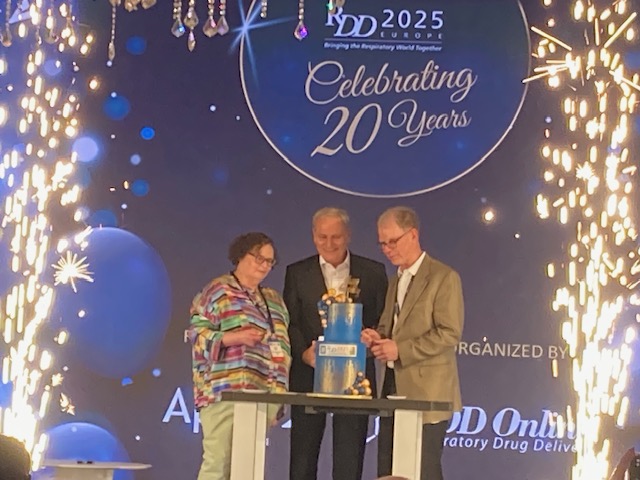
RDD Europe 2025, which took place in Estoril, Portugal May 6-9, welcomed approximately 490 delegates and 70 exhibitors from around the world to a meeting that focused on overcoming complex problems in order to advance inhaled and nasal drug delivery in a way that is more sustainable, personalized, and accessible. Attendees also joined organizers RDD Online and Aptar Pharma in celebrating the 20th year of RDD Europe.
Speakers throughout the conference proposed significant innovations in formulation, delivery devices, testing, and regulation that would be necessary in order to achieve and “future-proof” major advances in OINDP technology. While RDD 2024 presented an industry in transition, RDD Europe 2025 explored the possibilities of a future paradigm shift.
Recordings of the presentations and workshops have now been posted and will be available to delegates through June 30.
Inhalation 5.0
The “Advanced Inhalation” knowledge space introduced the concept of “Inhalation 5.0,” a term coined by RDD Online’s Joanne Peart. The proposed Inhalation 5.0 approach is based on Industry 5.0, a vision that is meant to be “sustainable, human-centric, and resilient.” Moderator Geraldine Venthoye of Phillips Medisize dedicated the first half of the session to an overview of the Inhalation 5.0 concept and then led discussion by a panel featuring Jayne Hastedt of JDP Pharma Consulting, Jan de Backer of Fluidda, David Shorthouse of University College London, Darragh Murnane of the University of Hertfordshire, and Carla Vozone of Catalent.
In her introduction, Venthoye set out her objective to prompt debate among those who feel that the industry is changing at “glacial speed,” with few advances presented from conference to conference, and she observed that many of the talks at RDD Europe 2025 did, in fact, relate to products and technologies that would be very different from today’s standards. Among the current trends she noted is the increasing number of systemic products in development as well as inhaled and nasal biologics.
Venthoye suggested that the future of inhaled and nasal drug development should center on more efficient development of more efficient, environmentally-friendly, and patient-centric products that are also “future-proofed.” Keeping OINDPs accessible to patients is also important, Venthoye emphasized. “It’s really important that we don’t load developments and then load cost to the patients and into healthcare . . . That tends to go against making them connected and including electronics,” she pointed out, adding that more generics will also be necessary.


